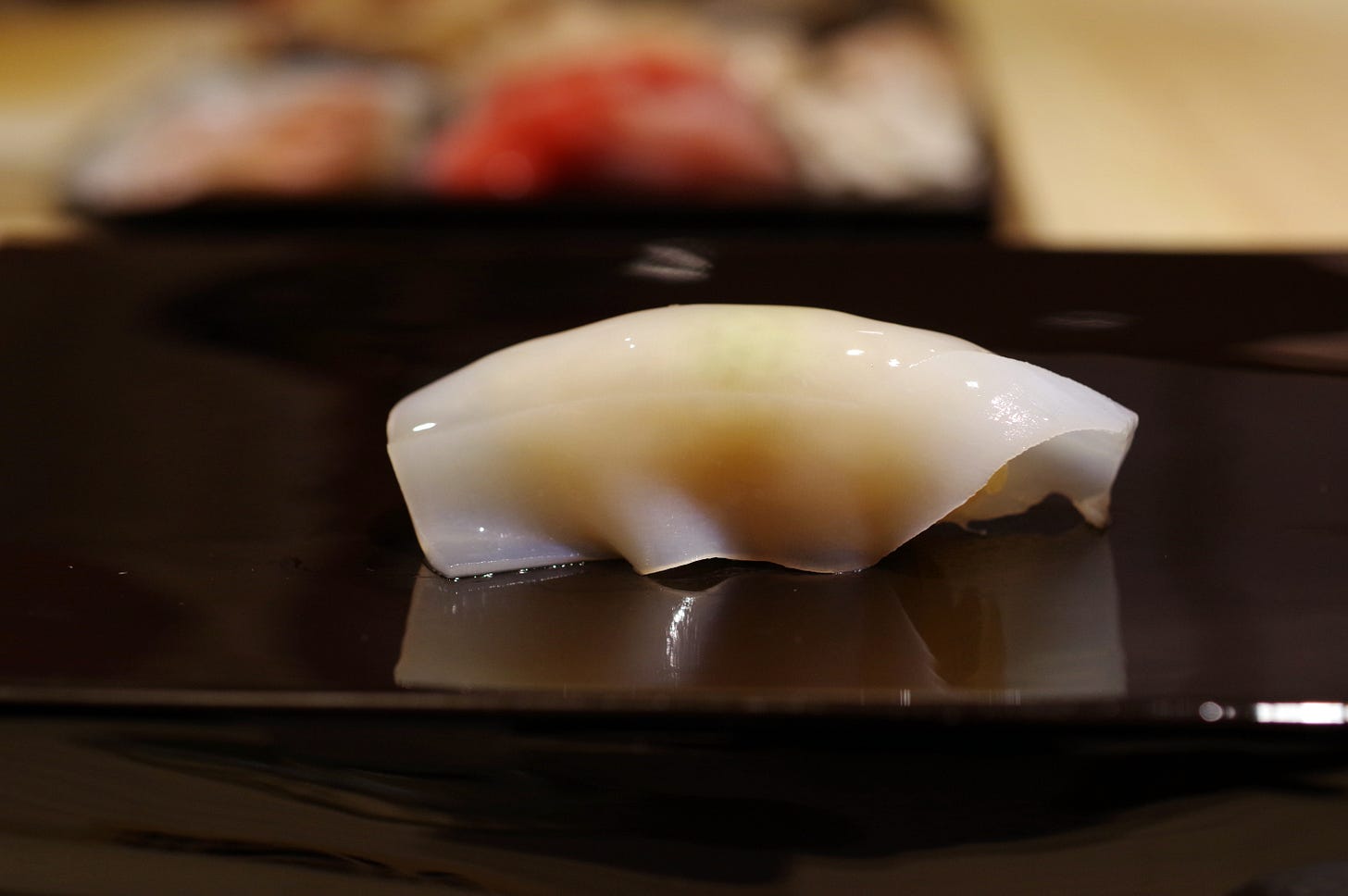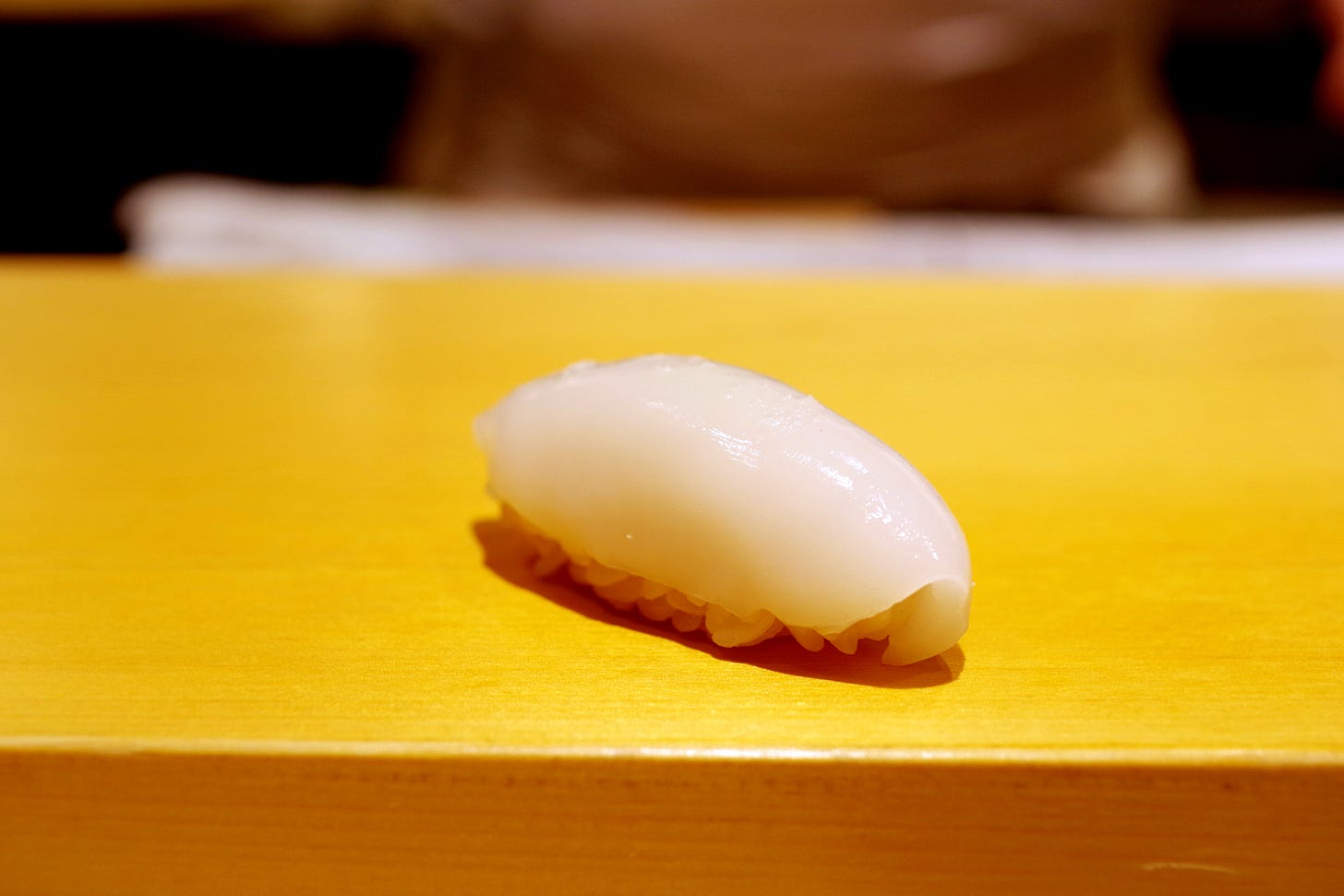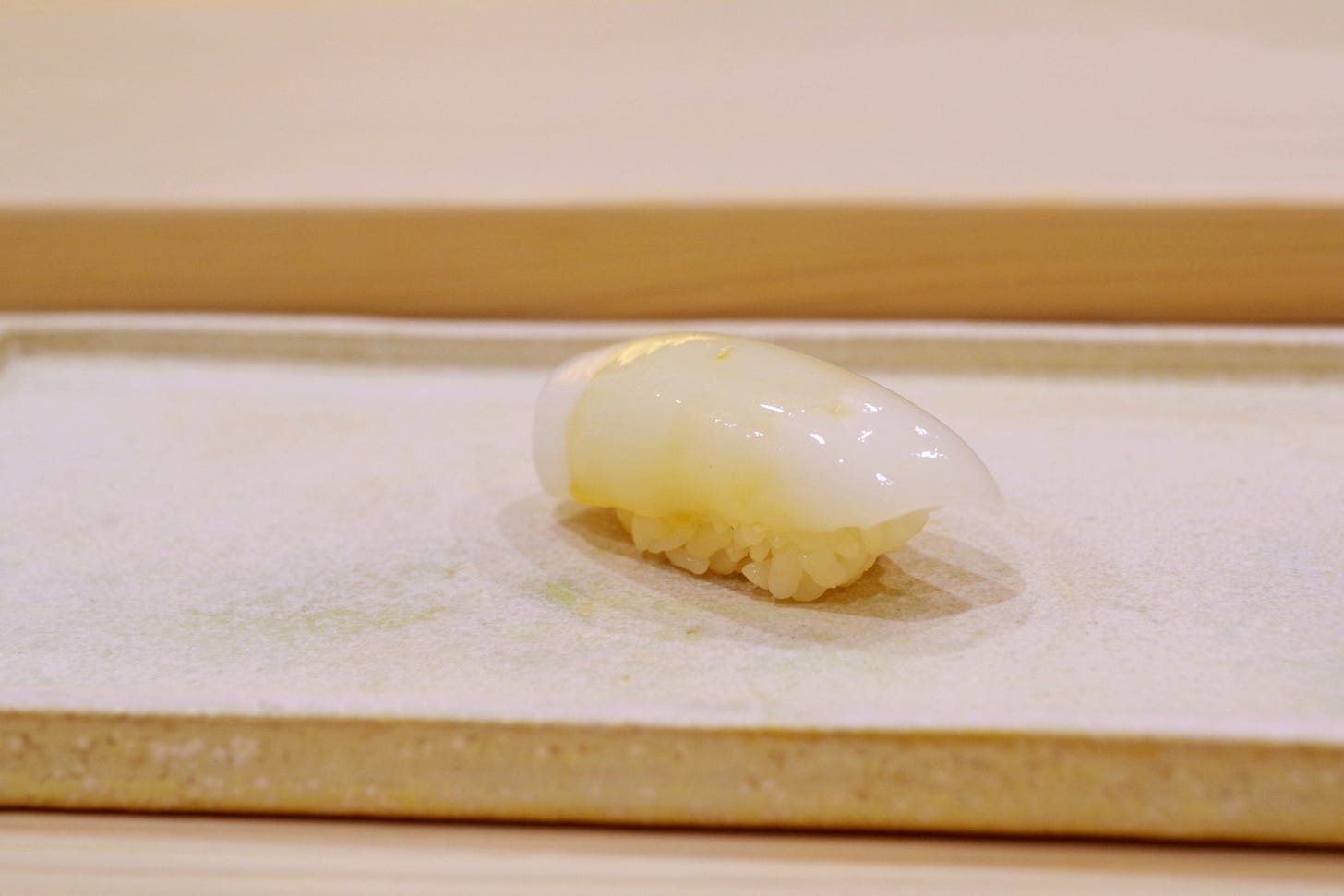For the 11th installment of "Traditional Sushi Varieties," I would like to introduce Cuttlefish and Young Cuttlefish. These are the typical and traditional ingredients of Edomae-zushi.
Cuttlefish (Sumi-ika)
Young Cuttlefish (Shin-ika)
Cuttlefish (Sumi-ika)
Japanese Name: Sumi-ika, Ko-ika
English Name: Cuttlefish
Main Seasonal: October to March
In the world of Edomae-zushi, the squid is almost exclusively referred to as "Sumi-ika," although its standard Japanese name is "Ko-ika." This particular squid is fascinating due to its unparalleled deliciousness when served in Edomae-style sushi. I firmly believe that among all squid species, the Japanese name "Sumi-ika" is the most fitting for Edomae-zushi. The primary reason for this is its unique texture. The squid's firm, crisp texture is more appealing than any other variety. Despite its robust texture, the fibers quickly unravel and gradually melt away in the mouth. In addition to its exceptional texture, the Sumi-ika also possesses an elegant sweetness and a delicate aroma that perfectly complement the acidity and saltiness of the sushi rice. The squid that achieves a harmonious taste and makes the best use of the rice is undoubtedly the Sumi-ika. The popular Aori-ika (bigfin reef squid) has a pronounced sweet taste and a melt-in-your-mouth texture, making it a great alternative during the summer when Sumi-ika is scarce. However, the taste of the rice, the skill of nigiri, and the precision of the knife work are more directly showcased when using Sumi-ika. In this respect, it is a sophisticated and refined type of sushi. It is easy to understand why skilled and experienced sushi chefs often choose Sumi-ika as their preferred sushi ingredient.
When savoring cuttlefish (Sumi-ika) at a sushi restaurant, pay attention to these key aspects:
Texture
Delicate sweetness and aroma typical of Sumi-ika
The taste of the rice
The texture of Sumi-ika varies depending on the chef's knife skills. While firmness is appealing, it is not enough for the squid to be merely hard, and it may not be sophisticated enough to be served with rice. It is fascinating to examine how the gradation of texture is expressed through the chef's knife work. It is also tactless to allow the attractive texture of Sumi-ika to sit for an extended period, as is the case with Aori-ika (bigfin reef squid). Making Sumi-ika soft and sweet is uninteresting; the true elegance of Sumi-ika lies in expressing its crispness through one's own knife skills.
To fully appreciate the delicate sweetness and aroma unique to Sumi-ika, it is essential to understand how the squid is seasoned. The most common serving styles are "salt only" or "salt and citrus fruits (such as sudachi or yuzu)." However, depending on the amount of citrus juice or shaved peel used, it can overpower the taste of the Sumi-ika. Although not limited to Sumi-ika, it is best to use garnishes and seasonings that complement and enhance the main ingredient. In addition to citrus fruits, the salt used should be rich in minerals and mild. If refined salt with a high sodium content is used, the taste will lack depth, and the saltiness will overshadow the flavor of the Sumi-ika. When enjoying delicately flavored sushi, it is crucial to be attentive to the gradation of textures and flavors to heighten the overall experience.
Lastly, it is also rewarding to appreciate the taste of the rice. You may wonder, "Why focus on rice when discussing Sumi-ika?" However, Sumi-ika and other white fish are excellent sushi types for capturing the unique character of a restaurant's rice. Once you have a good understanding of the rice's flavor profile, you should assess whether it complements the acidity, saltiness, sweetness, and aroma of the Sumi-ika. If you focus solely on the taste of the squid, it may seem bland. By tasting the Sumi-ika together with the rice, you can add depth and complexity to your dining experience.
Young Cuttlefish (Shin-ika)
Japanese Name: Shin-ika
English Name: Young Cuttlefish
Main Seasonal: August
The shin-ika, or young Sumi squid, is a prized sushi ingredient that begins to appear after the Bon Festival in mid-August and disappears within a mere two to few weeks. The season is exceptionally brief, making it a highly sought-after delicacy. As a staple of Edomae-zushi and a beloved favorite among connoisseurs, shin-ika commands a premium price. The cost per serving can range from 500 yen to 3,000 yen, translating to a staggering 1,500 yen to 9,000 yen per piece. The vast majority of people would undoubtedly exclaim, "That's outrageous!" However, sushi restaurants, in a display of their unwavering dedication and refinement, choose to serve shin-ika at a more reasonable price point. This practice exemplifies the indomitable willpower and sophistication of sushi chefs and the enduring spirit of the Edo people. Therefore, if you have the privilege of savoring shin-ika during its fleeting season in August, I wholeheartedly recommend revisiting that restaurant at a later time. Patronizing the establishment during a different season is an elegant way to express your gratitude and appreciation for their commitment to providing such a rare and exquisite experience.
When savoring young cuttlefish (shin-ika) at a sushi restaurant, pay attention to these key aspects:
Texture
Sumi-ika-like texture
The allure of shin-ika lies in its unique texture. As a juvenile squid, its flesh is more tender than that of adult Sumi-ika, yet it possesses a firm, Sumi-ika-like texture. This ephemeral and delectable charm is truly captivating. Since shin-ika appears after the season of Aori-ika (bigfin reef squid), some diners may find it lacking in flavor. However, such an assessment is both tactless and indicative of a lack of taste and imagination. Shin-ika is a fleeting delicacy, available for less than a month. Those who can appreciate its true value are the genuine sushi aficionados.
If you have the opportunity to purchase shin-ika, be sure to inquire about its storage method. This is a valuable piece of knowledge I acquired from a sushi chef. Squid has a tendency to absorb water, so proper storage is crucial to maintain its quality and texture.
That's all for now. I look forward to seeing you again! If you want to remember sushi toppings and fish varieties discussed in this chapter, please refer to this linked article.
I hope you're looking forward to my next article!
If you enjoy this article, please share it on your social networks. Your support inspires me to keep writing!
The TOC of “Spirits of Sushi“
The History of Sushi
Exploring Sushi Varieties: Edomae-zushi (Nigiri-zushi), Kansai-zushi, and More
Essential Sushi Vocabulary: Key Terms for Navigating a Sushi Restaurant
The Heart of Sushi: A Guide to “Shari”, Sushi Rice
A Deep Dive into Sushi Fish and Accompaniments
The Art of the Sushi Master: Traditional Japanese Knives
Japan's Exquisite Fish Culture: From Tsukiji to Toyosu Market and Various Regions
Must-Visit Sushi Restaurants: From Tokyo to Sapporo, Fukuoka, and Other Regions
Regional Sushi Styles: Exploring Japan's Diverse Sushi Culture
Sushi and Sake Pairings: A Culinary Adventure
Sushi Etiquette and Table Manner: Dining like a Sophisticated Local
Shopping in Japan: Essentials for Crafting Delicious Sushi at Home
Sushi in Pop Culture: Manga and Movies
Sushi: A Lens on Health and Sustainability
Wrapping Up: The Future of Sushi








